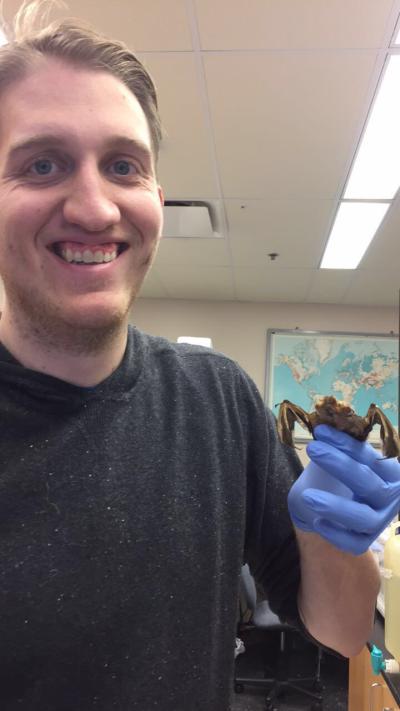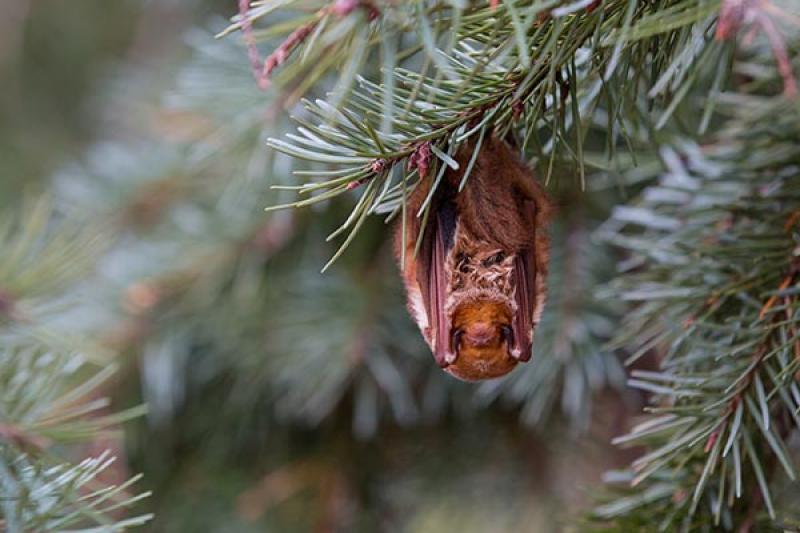
Hi, everyone. I’m Jamin Wieringa, a PhD student currently finishing up my sixth year in EEOB having started in August 2016. I am advised by Professors Lisle Gibbs and Bryan Carstens. Before coming to OSU, I went to Hope College in Holland, MI for my undergraduate degree in biology, and I followed this up by going to Central Michigan University for my master’s degree in biology with a conservation focus.
Most of my dissertation has focused on questions related to bats and bat migration, but I also have broad interests beyond this related to the evolution of migration. I like to think of myself as a migration or movement biologist, with an interest in spatial ecology. Specifically, my dissertation research has looked at bat migration and its relationship with wind farms. Wind farms are a huge issue with migratory tree bats in North America. Despite the economic and ecological benefits of bats eating insects, many studies estimate huge declines in bat population numbers due to wind farm mortality. As a result, we need to better understand the interactions of wind farms and bat migration. My first chapter was focused on modeling migration routes that bats might be using. I was able to show that bats are likely following landscape features like mountain ranges and rivers, which may have implications for future wind farm placement. However, we need more concrete estimates of bat migration and the causes of bats that die at wind farms.
To address the questions of origin and migration, we need new approaches to understand bat migration. Historically, the most common approach in North America is to use hydrogen isotopes to determine where bats summered. This approach lacks spatial resolution, though, as we tend to predict latitudinal bands, i.e., we might predict all of Pennsylvania, Ohio, Indiana, Illinois, and more. My goal has been to come up with ways to better determine the likely summering grounds of these bats. To do that, I first started by trying to find a new biomarker that we can use to predict the likely summering area. Biomarkers are intrinsic markers that are incorporated into tissue and are stable over time. I tried using trace elements, those rare elements that accumulate in the fur as these vary across geographical space, but in patterns different to those of hydrogen isotopes. Nevertheless, we ran into similar issues in that the results predicted large expanses of area as the likely summering grounds. We next took both isotopes and trace elements and combined them to determine if that gives us better spatial resolution. I was able to show that for some species this combined approach provided better predictions than either method alone. Finally, while still a work in progress, I plan to work to determine the origin of bats killed at wind farms in Ohio to see whether they are from local populations or are migratory.

This hasn’t been all my work though. While a part of EEOB I have had the pleasure of collaborating with many individuals and contributing to group projects, both of which have led to publications and new skills. I have worked on side projects that predicted the extinction risk for all IUCN Data Deficient bat species across the globe, and I mentored undergraduate students to develop projects and teach them valuable skills for their next career steps. I have had the opportunity to be apart of GEES, the Graduate Evolution & Ecology Student organization,including serving as president for two years. It was a challenge, especially as COVID hit, but it allowed me to become more aware of the diverse experiences graduate students have, to learn more about myself through reflection on my own experiences.
